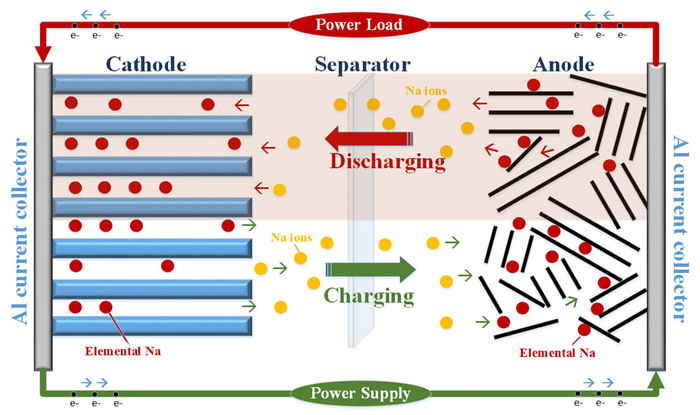
In fact, as early as the 1980s, research on sodium-ion batteries had already begun. The electrode materials designed and developed in the early days, such as MoS2, TiS2, and NaxMO2, have poor electrochemical performance, and their development is very slow.

Schematic representation of a Na-ion battery cell (Source:Internet)
This schematic illustrates the functioning of sodium-ion batteries. The high cost and scarcity of lithium are driving research to develop alternatives to lithium-ion batteries, especially to meet future needs in energy storage. One potential alternative is sodium-ion batteries. (Purdue University image/Vilas Pol)
A sodium-ion battery is a kind of secondary battery (rechargeable battery), which mainly relies on the movement of sodium ions between the positive and negative electrodes to work, similar to the working principle of lithium-ion batteries. As I just said, neither sodium batteries nor lithium batteries have been discovered in the past two years. It can be said that these two batteries were equally popular in the 1980s, but due to various reasons, sodium batteries have faded out. To improve people's vision. In the periodic table of the elements, sodium and lithium are the closest metal elements of the same group, and their chemical properties are very similar. The number of electrons used in the outermost layer of the battery is exactly the same. The carrying capacity of lithium-ion batteries and sodium-ion batteries in charge and discharge reactions are also consistent.
Why did "sodium batteries" disappear from direct sales? Is it because the technology is immature? In fact, it is not. The technical principles of sodium batteries have long been mature and a complete system was formed at that time. Both of these two battery technologies use metal ions as charge carriers. In this transfer process, the charge carries the metal ions and is transferred between the positive electrode and the negative electrode to realize the charge and discharge of the battery. From the point of view of the transmission efficiency of the two, since the amount of electricity carried in the charge and discharge reaction is the same, the transmission efficiency is also the same.
Advantages of sodium batteries
The electrode material used in sodium-ion batteries is mainly sodium salt, which is more abundant and cheaper than lithium. Since sodium-ions are larger than lithium-ions, sodium-ion batteries are a cost-effective alternative when weight and energy density are not high requirements. Compared with lithium-ion batteries, sodium-ion batteries have the following advantages:
1.The sodium salt raw material reserves are abundant and the price is low. Compared with the ternary cathode material of lithium-ion battery, the iron-manganese-nickel-based cathode material is used, and the raw material cost is reduced by half;
2.Due to the characteristics of sodium salt, it is allowed to use low-concentration electrolyte (with the same concentration of electrolyte, the conductivity of sodium salt is about 20% higher than that of lithium electrolyte) to reduce costs;
3.sodium-ions do not form an alloy with aluminum, and aluminum foil can be used as the current collector for the negative electrode, which can further reduce the cost by about 8% and reduce the weight by about 10%;
4.Since the sodium-ion battery has no over-discharge characteristics, the sodium-ion battery is allowed to discharge to zero volts. The energy density of sodium-ion batteries is greater than 100Wh/kg, which is comparable to lithium iron phosphate batteries, but its cost advantage is obvious, and it is expected to replace traditional lead-acid batteries in large-scale energy storage.
At present, one of the main cost sources of new energy vehicles is the battery. The several advantages of sodium-ion batteries are related to cost. It can be seen that it is expected to reduce the overall cost of new energy vehicles in the future, but its disadvantages are also very obvious: low energy density

NASTAR BATTERY
Address:Shenzhen city, Guangdong Province China
Email:info@sodiumbatterycn.com
www.sodiumbatterycn.com

